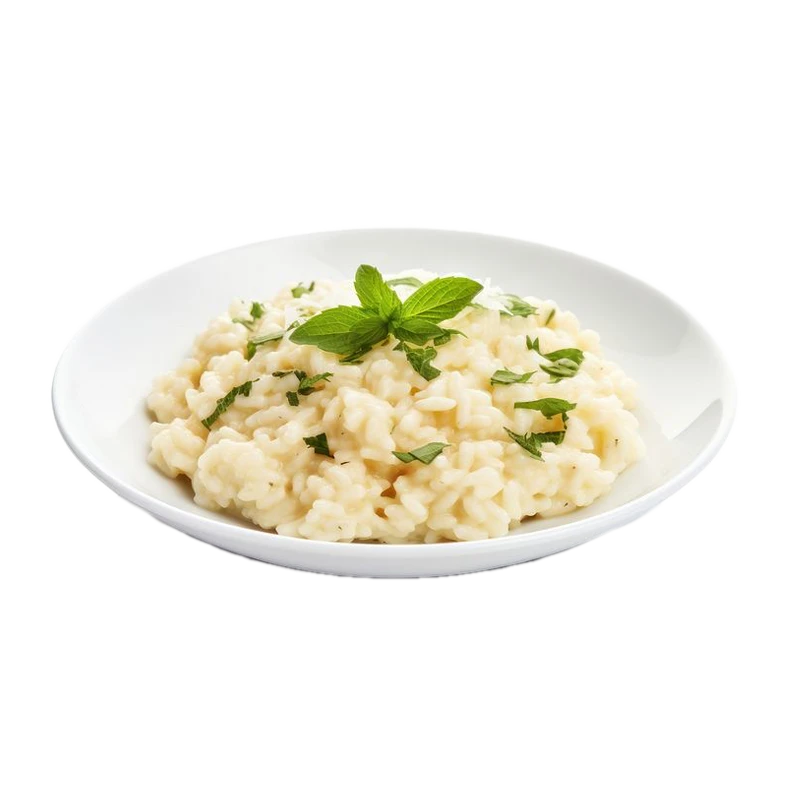Risotto — Nutrients, Health Benefits, And Shopping Tips

Written by Listonic Team
Last update on September 4, 2024
Risotto nutrients
Nutrition facts
Amount per 100 g
Calories
🔥 153 kcal
| Nutrition per: 100 g | Value | % Daily Value* |
|---|---|---|
| Carbs | 24 g | 8.73% |
| Fiber | 1 g | 3.57% |
| Sugars | 0 g | - |
| Glycemic Index | 69 | - |
| Protein | 5 g | 10% |
| Sodium | 400 mg | 17.39% |
| Total Fat | 4 g | 5.13% |
*The % of Daily Value (DV) tells you how much a nutrient in a serving of food contributes to a daily diet. 2,000 calories a day is used for general nutrition advice.
Risotto facts & tips
Health benefits
- Provides carbohydrates, which are a primary source of energy for the body and brain.
- Can be rich in protein if made with ingredients like cheese, meat, or seafood, supporting muscle growth and repair.
- Contains essential vitamins and minerals from various ingredients, such as B vitamins, iron, and magnesium, supporting overall health and well-being.
- Versatile and nutritious when made with a variety of vegetables, lean proteins, and whole grains.
Health risks
- High carbohydrate content as risotto is typically made with refined Arborio rice, which can cause rapid spikes in blood sugar levels, particularly concerning for diabetics.
- High fat content particularly in risotto recipes made with butter, cheese, or cream, which can raise cholesterol levels and increase the risk of heart disease.
- High sodium content particularly in commercial or restaurant-prepared risottos, which can contribute to hypertension and increased cardiovascular risks.
- Potential for overconsumption due to its rich and creamy texture, leading to excessive calorie intake if not mindful of portion sizes.
How to choose risotto
Risotto rice should be plump and have a uniform appearance, with a slightly opaque center when uncooked. The grains should be firm, ensuring they will absorb liquids well without becoming mushy.
Do not select risotto rice that appears dusty or has a stale odor, as these conditions can affect the final dish's flavor and texture. Rice that cooks up sticky or clumps together should also be avoided, as true risotto should be creamy yet retain distinct grains.

How to store risotto
Leftover risotto should be stored in the refrigerator in an airtight container. This helps maintain its creamy texture and flavor for up to three days. Ensure it is fully cooled before covering and refrigerating.
Leaving risotto at room temperature can lead to rapid spoilage. Avoid using metal containers for storage, as they can affect the taste. Always reheat only the portion needed to preserve the risotto's texture and flavor.
✅ Extra Tip
How long does it last?
Risotto can last for 3-5 days in the refrigerator once cooked. For longer storage, it can be frozen for up to 2 months.
What to do with leftovers?
Leftover risotto can be used in a variety of comforting and flavorful dishes. Reheat it and serve as is, or use it as a filling for arancini (fried risotto balls), where it can be stuffed with cheese and then fried until crispy. Risotto is also great when mixed into a baked casserole with vegetables, cheese, and breadcrumbs.
Use leftover risotto as a base for a rice cake by pressing it into patties and frying until golden, or mix it into a frittata or quiche with eggs and cheese. If you have a lot of risotto, consider making a batch of risotto-stuffed vegetables like peppers or tomatoes, where the creamy rice pairs well with the fresh vegetables. Risotto can also be transformed into a creamy soup by adding broth and additional vegetables, or used as a stuffing for meat or fish. For a quick meal, reheat risotto and top with a poached egg or a sprinkle of fresh herbs.
👨⚕️️ Medical disclaimer
Discover products from other categories
Listonic Team
Fact-checked
Our editorial team checked this article to make sure it was accurate at the time of publishing it.
Get the top-rated shopping list app

risotto
1 piece







